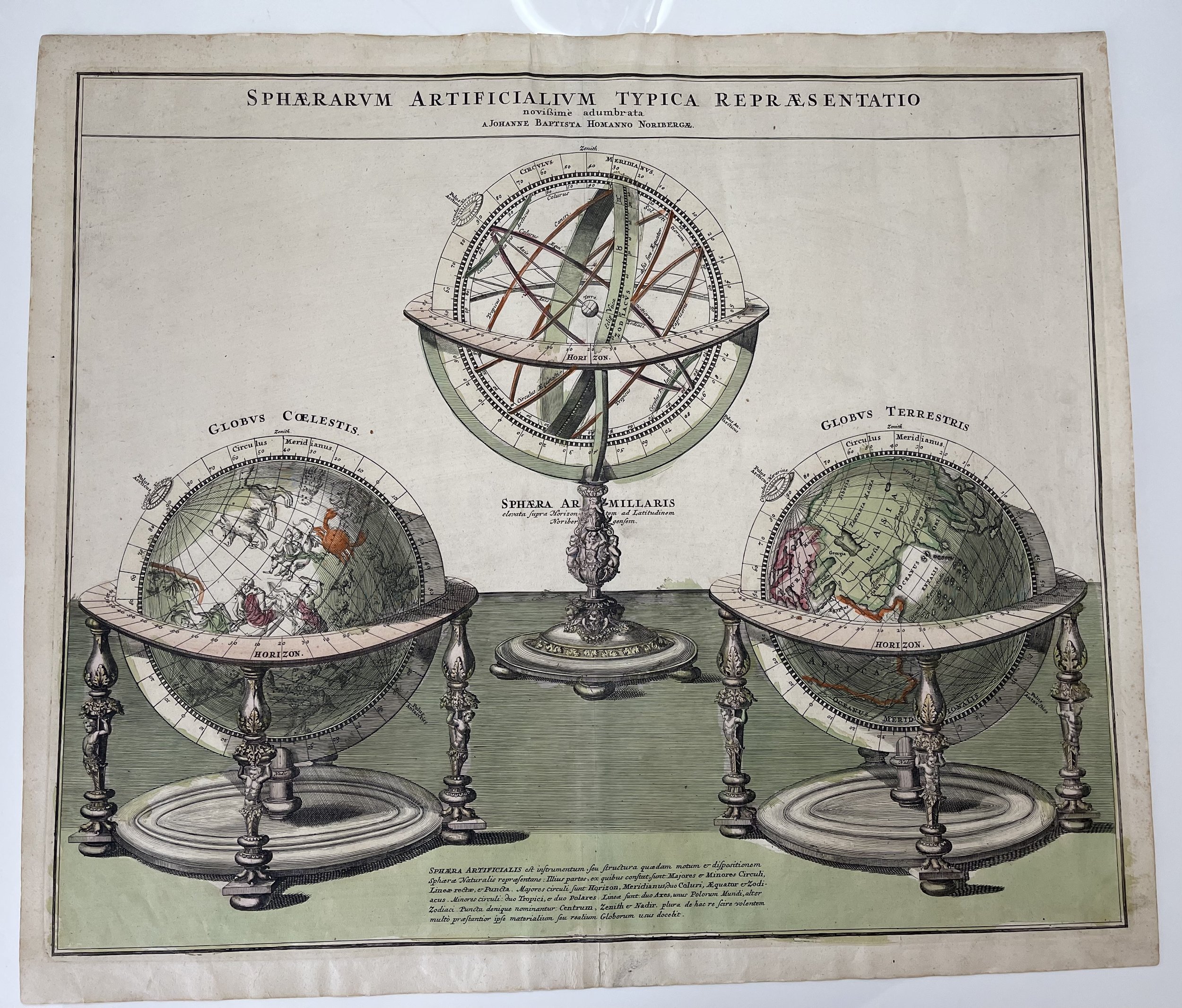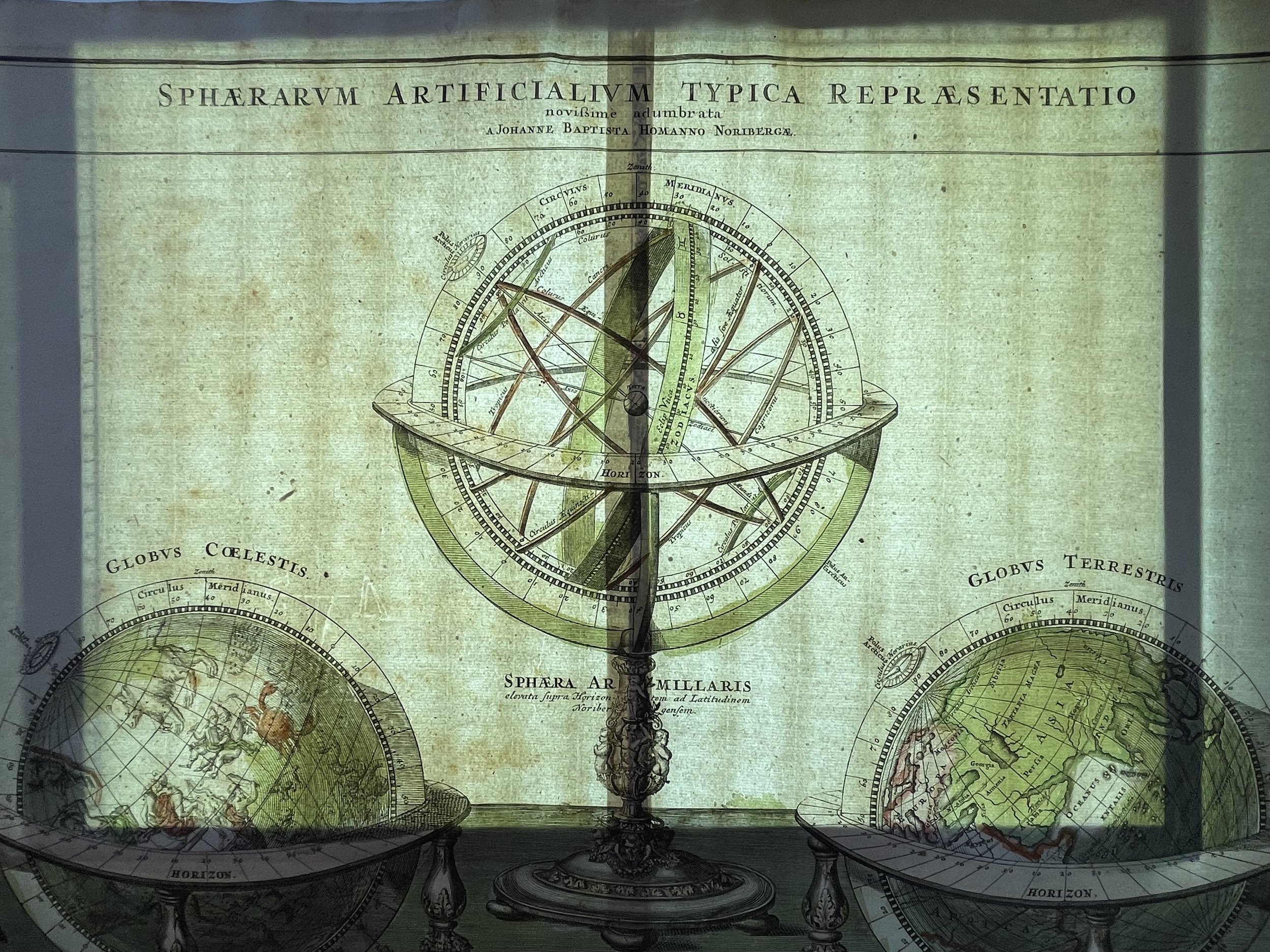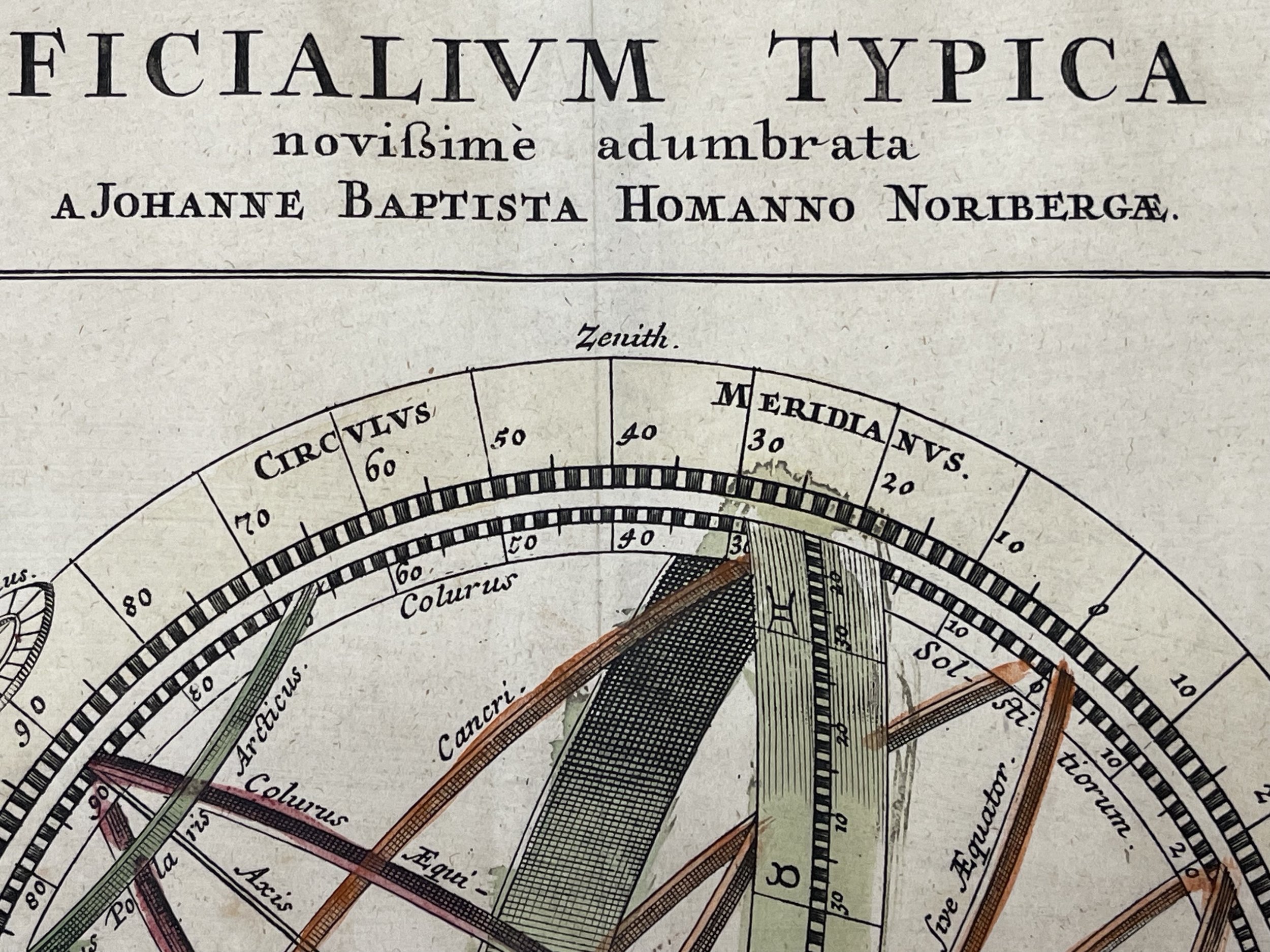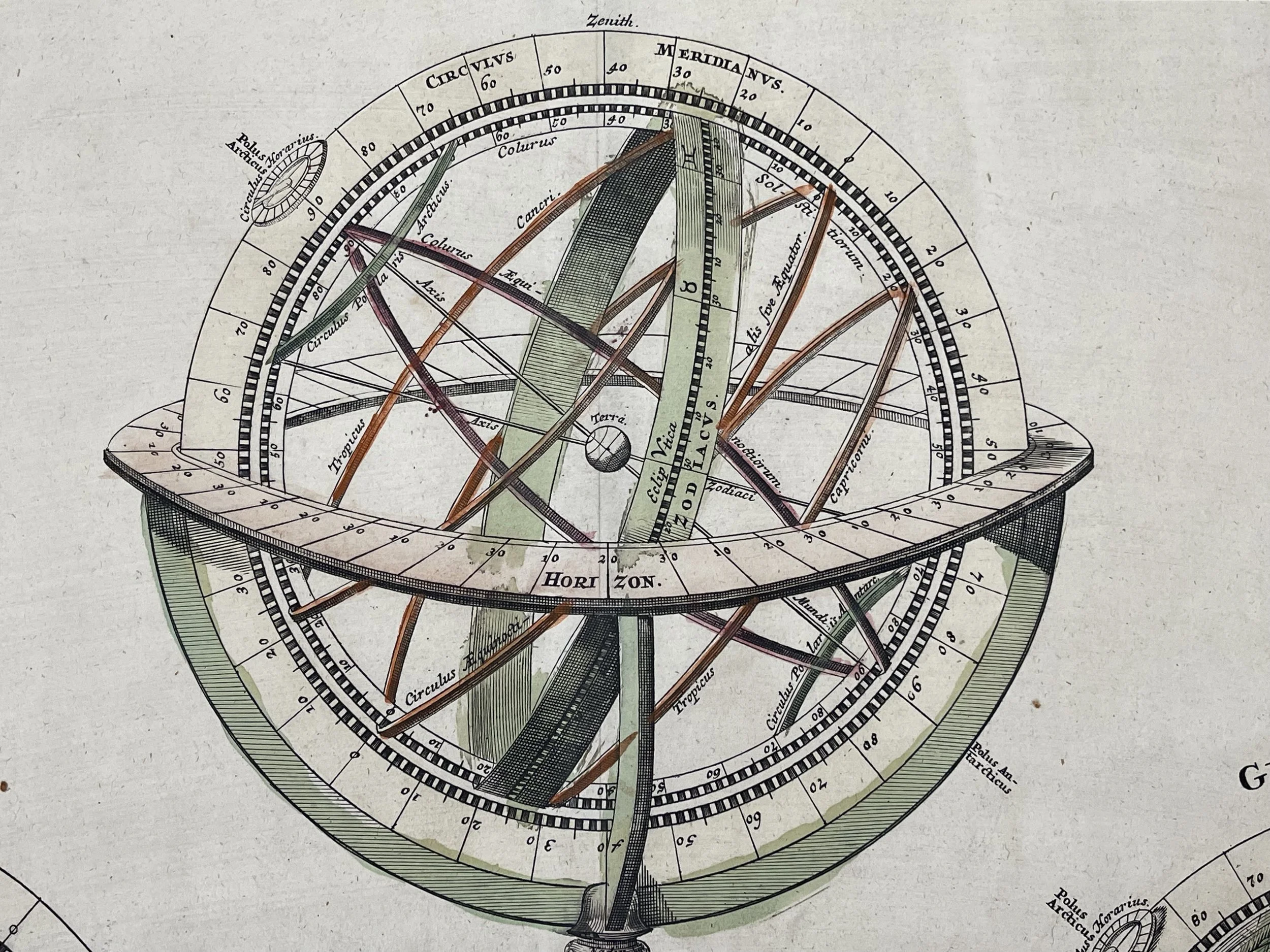 Image 1 of 15
Image 1 of 15

 Image 2 of 15
Image 2 of 15

 Image 3 of 15
Image 3 of 15

 Image 4 of 15
Image 4 of 15

 Image 5 of 15
Image 5 of 15

 Image 6 of 15
Image 6 of 15

 Image 7 of 15
Image 7 of 15

 Image 8 of 15
Image 8 of 15

 Image 9 of 15
Image 9 of 15

 Image 10 of 15
Image 10 of 15

 Image 11 of 15
Image 11 of 15

 Image 12 of 15
Image 12 of 15

 Image 13 of 15
Image 13 of 15

 Image 14 of 15
Image 14 of 15

 Image 15 of 15
Image 15 of 15
















Sphaerarum Artificialum Typica Repraesentatio.- Johann Baptist Homann - 1720
Large, Incredibly detailed and scarce engraving of a Celestial Terrestrial Globe & Armillary Sphere map by Johann Baptist Homann Circa 1720-26
Title: Sphaerarum Artificialum Typica Repraesentatio.
This very decorative engraving is from one of Homann's celestial atlases. It illustrates a pair of terrestrial and celestial globes and a matching armillary sphere, all on Baroque library stands. The armillary sphere is a model of the celestial sphere, consisting of a spherical framework of rings, cantered on Earth, that represent lines of celestial longitude and latitude and the ecliptic. The terrestrial globe shows Asia, Europe and Africa and the celestial shows various constellations with figures according to Greek mythology. Each of the Baroque stands incorporates caryatid elements in the supports, together with other classical ornamentation.
The Homann Family
Johann Baptist Homann (1664-1724)
Was born in Oberkammlach, located in Southern Germany. He then moved to Vienna around 1693, where he resided and studied the art of printing and copper plate engraving until 1695. In 1702, he established a map publishing business in Nuremberg, which eventually became one of the most prominent German map publishing companies of the 18th century. During this time, Homann produced numerous maps, showcasing his distinct style characterized by intricate engravings, intricate allegorical cartouches, and vibrant hand coloring. His first atlas was published in 1707 and his company became a major competitor of other leading European mapmakers. In 1715, Homann's exceptional work caught the eye of the Holy Roman Emperor Charles VI, who appointed him as the Imperial Cartographer. The same year, Homann was also inducted into the Royal Academy of Sciences in Berlin. As a result, he gained access to the latest cartographic information and received the "Privilege" along with his prestigious title. In 1716, Homann published his magnum opus, the Grosser Atlas über die ganze Welt (Grand Atlas of all the World). After his passing in 1724, his son Johan Christoph Homann (1703-1730) and other heirs took over the company, operating under the name Homann's Erben (Homann's Heirs) until 1852. He was engraver, map-seller and geographer to the Kaiser of the Holy Roman Empire (1715). He also was member of the Prussian Royal Academy of Science.
Stunning engraving of Homann's terrestrial and celestial globes and armillary sphere, all with highly ornamented stands. Brief explanatory text.
Excellent condition for its 300+ years of age. Watermaks shown on lightbox photo. Pricing and grading commensurate.
Large, Incredibly detailed and scarce engraving of a Celestial Terrestrial Globe & Armillary Sphere map by Johann Baptist Homann Circa 1720-26
Title: Sphaerarum Artificialum Typica Repraesentatio.
This very decorative engraving is from one of Homann's celestial atlases. It illustrates a pair of terrestrial and celestial globes and a matching armillary sphere, all on Baroque library stands. The armillary sphere is a model of the celestial sphere, consisting of a spherical framework of rings, cantered on Earth, that represent lines of celestial longitude and latitude and the ecliptic. The terrestrial globe shows Asia, Europe and Africa and the celestial shows various constellations with figures according to Greek mythology. Each of the Baroque stands incorporates caryatid elements in the supports, together with other classical ornamentation.
The Homann Family
Johann Baptist Homann (1664-1724)
Was born in Oberkammlach, located in Southern Germany. He then moved to Vienna around 1693, where he resided and studied the art of printing and copper plate engraving until 1695. In 1702, he established a map publishing business in Nuremberg, which eventually became one of the most prominent German map publishing companies of the 18th century. During this time, Homann produced numerous maps, showcasing his distinct style characterized by intricate engravings, intricate allegorical cartouches, and vibrant hand coloring. His first atlas was published in 1707 and his company became a major competitor of other leading European mapmakers. In 1715, Homann's exceptional work caught the eye of the Holy Roman Emperor Charles VI, who appointed him as the Imperial Cartographer. The same year, Homann was also inducted into the Royal Academy of Sciences in Berlin. As a result, he gained access to the latest cartographic information and received the "Privilege" along with his prestigious title. In 1716, Homann published his magnum opus, the Grosser Atlas über die ganze Welt (Grand Atlas of all the World). After his passing in 1724, his son Johan Christoph Homann (1703-1730) and other heirs took over the company, operating under the name Homann's Erben (Homann's Heirs) until 1852. He was engraver, map-seller and geographer to the Kaiser of the Holy Roman Empire (1715). He also was member of the Prussian Royal Academy of Science.
Stunning engraving of Homann's terrestrial and celestial globes and armillary sphere, all with highly ornamented stands. Brief explanatory text.
Excellent condition for its 300+ years of age. Watermaks shown on lightbox photo. Pricing and grading commensurate.
Large, Incredibly detailed and scarce engraving of a Celestial Terrestrial Globe & Armillary Sphere map by Johann Baptist Homann Circa 1720-26
Title: Sphaerarum Artificialum Typica Repraesentatio.
This very decorative engraving is from one of Homann's celestial atlases. It illustrates a pair of terrestrial and celestial globes and a matching armillary sphere, all on Baroque library stands. The armillary sphere is a model of the celestial sphere, consisting of a spherical framework of rings, cantered on Earth, that represent lines of celestial longitude and latitude and the ecliptic. The terrestrial globe shows Asia, Europe and Africa and the celestial shows various constellations with figures according to Greek mythology. Each of the Baroque stands incorporates caryatid elements in the supports, together with other classical ornamentation.
The Homann Family
Johann Baptist Homann (1664-1724)
Was born in Oberkammlach, located in Southern Germany. He then moved to Vienna around 1693, where he resided and studied the art of printing and copper plate engraving until 1695. In 1702, he established a map publishing business in Nuremberg, which eventually became one of the most prominent German map publishing companies of the 18th century. During this time, Homann produced numerous maps, showcasing his distinct style characterized by intricate engravings, intricate allegorical cartouches, and vibrant hand coloring. His first atlas was published in 1707 and his company became a major competitor of other leading European mapmakers. In 1715, Homann's exceptional work caught the eye of the Holy Roman Emperor Charles VI, who appointed him as the Imperial Cartographer. The same year, Homann was also inducted into the Royal Academy of Sciences in Berlin. As a result, he gained access to the latest cartographic information and received the "Privilege" along with his prestigious title. In 1716, Homann published his magnum opus, the Grosser Atlas über die ganze Welt (Grand Atlas of all the World). After his passing in 1724, his son Johan Christoph Homann (1703-1730) and other heirs took over the company, operating under the name Homann's Erben (Homann's Heirs) until 1852. He was engraver, map-seller and geographer to the Kaiser of the Holy Roman Empire (1715). He also was member of the Prussian Royal Academy of Science.
Stunning engraving of Homann's terrestrial and celestial globes and armillary sphere, all with highly ornamented stands. Brief explanatory text.
Excellent condition for its 300+ years of age. Watermaks shown on lightbox photo. Pricing and grading commensurate.
Code : A624
Cartographer : Cartographer / Engraver / Publisher: Johann Baptist Homann
Date : Publication Place / Date - Circa 1720-26
Size : Sheet size: approx 48.5 x 57.5 Cm
Availability : Available
Type - Genuine - Antique
Grading A
Where Applicable - Folds as issued. Light box photo shows the folio leaf centre margin hinge ‘glue’, this is not visible otherwise.
Tracked postage, in casement. Please contact me for postal quotation outside of the UK.